It’s here already. The only thing you have to do is agree with it.
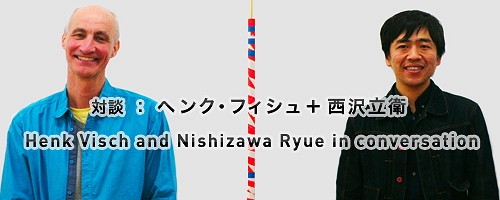
Henk Visch is known as a reclusive sculptor, and an artist with a gift for subtly manipulating the properties of spaces. Nishizawa Ryue meanwhile is a rising star in architectural design whose projects range from art museums to housing, focusing on what happens in these spaces, and the relationships within them and with the surrounding environment. This conversation between the pair, first connected when Visch staged an exhibition at Nishizawa’s Moriyama House compound in Tokyo, took place just as Visch was opening a solo show in the Japanese capital, and Nishizawa had been awarded the Pritzker Prize. Moving beyond the confines of their respective domains, they discussed their different approaches to the challenge of creative work.
by Pamela Miki
Nishizawa Ryue: Congratulations on your show here in Tokyo; it’s full of pleasant surprises. The figures I am more familiar with, but the linear constructions strike me as a new direction. The largest of those works [I have seen real happiness nowhere, but it is doubtless here (2010)] looks almost like a gate and at the same time an abstract drawing. What inspired this direction?
Henk Visch: In David Lynch’s Twin Peaks there is a cave drawing that takes on great importance because it contains a secret: if you can understand the drawing, you will know who killed Laura. As I was working on this piece I thought, this is like a cave drawing – you can read it, but you don’t know what it means.
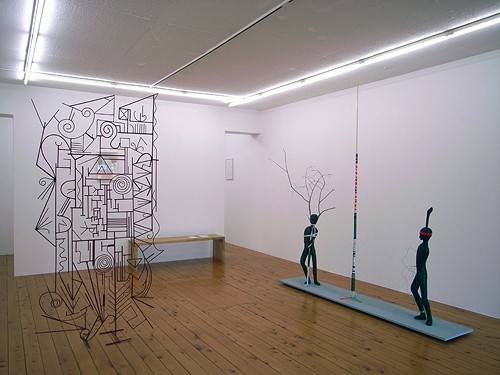 (Left) I have seen real happiness nowhere, but it is doubtless here 2010 Metal, h210 cm (Right) I was in your dream and could not sleep, 2010
(Left) I have seen real happiness nowhere, but it is doubtless here 2010 Metal, h210 cm (Right) I was in your dream and could not sleep, 2010© Henk Visch Courtesy Wako Works of Art
NR: So if we can read the work, we’ll know who killed Laura? (Laughs)
HV: (Laughing) There are no words or no literal meaning that you can find; it is more about language, about the idea of reading. And yes, it is like a gate – a gate you can go through with your eyes, but not with your body. In that sense it is similar to the work it stands juxtaposed to in this show. In I was in your dream and could not sleep (2010) the two bronze figures are the same – they are from the same mold – and the pole in the center acts as a mirror. In the mirror things become virtual; they disappear.
NR: The mirror creates another wall behind the wall, another space behind the space. Still these two works strike me as very different.
HV: To me the figures are solitary entities. They are closed, restricted, self-contained. They try to hide themselves in themselves, but they cannot hide anything more. They are antisocial, egocentric; they have no sensitive parts, no surface you can enter – and they need space. So by making the linear constructions, which to me are like space, I give the figures the space they lack.
Any space can be a space for art
NR: My first contact with your work was the piece you made in collaboration with Rem Koolhaas for the Kunsthal Rotterdam, which he of course designed. What struck me was what a beautiful feeling – a sense of serenity – it brought to the architecture. It created a different world. And yet it simply consists of two figures walking – a man and a camel.
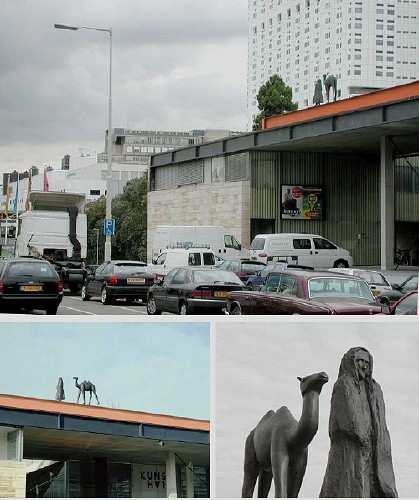 Kameel met begeleider (1992), Kunsthal Rotterdam © Henk Visch
Kameel met begeleider (1992), Kunsthal Rotterdam © Henk VischHV: I made that piece in the early ’90s, when there was a big influx of people from Islamic countries to the Netherlands, and with it a lot of social tension. Since it was a public sculpture, I decided to incorporate this issue into the piece. I likened the figures to ships, playing off of the saying ‘the camel is the ship of the desert’. And this being Holland, I had the camel going towards the sea – integrating with society, so to speak. The funny thing is that around that time when Rem made a catalogue for his Villa Dall’Ava project in Paris, he hired animals as models for the photographs.
NR: Yes, I remember that catalogue, with the giraffe in the garden. It was odd indeed to see a giant beast standing in a residential garden. You obviously inspired him. Did you work very closely with Rem on the Kunsthal project?
HV: Rem was instrumental to the art project because he was on the jury for the commission, which I won because Rem was very much in favor of my proposal. My original idea was to have a blue square around the entire Kunsthal, like a sea, and in the blue square, a camel – but the city opposed it. So Rem and I then worked together on developing the new approach.
NR: I was unaware of the original concept. It’s a beautiful idea.
HV: But then it went to sea (laughs). Sometimes you have to lose something first, in order to win.
NR: At the Moriyama House exhibition the architectural space and the artworks forged a very happy relationship. In fact, it was one of the most impressive ways of using the space I’d ever seen. The building had originally been designed as a residence, but you changed the program completely: you made it a museum. You placed works in what I had designed to be a small bathroom and kitchen in such a way that they took on a different function. It demonstrated exquisitely that any space can be a museum, that any space can be a space for art.
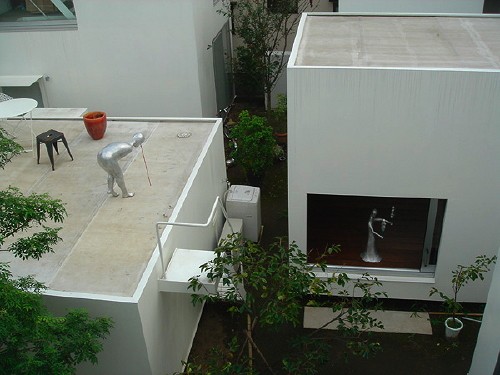
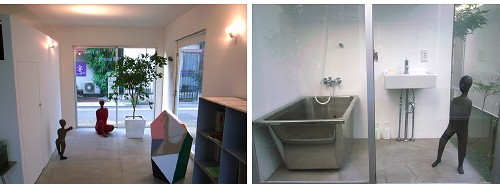
Installation views of Henk Visch at Moriyama House 2006
© Henk Visch Courtesy Wako Works of Art
Read Visch’s text on the Moriyama House and exhibiton at
http://www.henkvisch.nl/texts/33text.html
HV: But there was one space in the Moriyama House that I didn’t want to use: the space with no door, that Mr Moriyama uses to listen to music, with just a rectangular opening.
NR: (Laughs) That’s the door.
HV: Oh!? (Laughs) What is a classic piece of cultural misinterpretation! I felt it was a space that I should keep to remember space. It seemed like a prototype for all the other buildings, and I thought it should never be lost in using. Sometimes I think houses need is a place where you never go.
NR: A place where you never go – that’s a nice idea.
Henk Visch
Born 1950 in Eindhoven (NL), lives and works in Eindhoven. After boyhood dreams of becoming a conductor, actor, composer and architect, among other things, in 1980 he finally settled into his career as an artist. His great many commissioned sculptures appear in a wide variety of architectural settings including the Dutch Pavilion at the Shanghai Expo. International exhibitions include the 1988 Venice Biennale and Documenta IX (1992). In 2006 he exhibited works throughout the Moriyama House (Tokyo), a residence designed by architect Nishizawa Ryue.
http://www.henkvisch.nl/
Nishizawa Ryue
Born 1966 in Kanagawa. Established SANAA (Sejima And Nishizawa And Associates) with Sejima Kazuyo in 1995 and the Office of Ryue Nishizawa in 1997. Major works include the 21st Museum of Contemporary Art, Kanazawa, the New Museum (New York) and Towada Art Center. Professor at Yokohama National University. Winner with Sejima Kazuyo of the 2010 Pritzker Prize.
http://www.sanaa.co.jp/
http://www.ryuenishizawa.com/
Henk Visch: I have seen happiness nowhere, but it is doubtless here
2 April – 22 May
Wako Works of Art (Tokyo)
http://www.wako-art.jp/
Supported by the Embassy of the Kingdom of the Netherlands, Japan
Teshima Art Project (Teshima Museum of Art: designed by Nishizawa Ryue; Artwork by Naito Rei)
Setouchi International Art Festival 2010
19 July – 31 October
Teshima, Kagawa
http://setouchi-artfest.jp/
